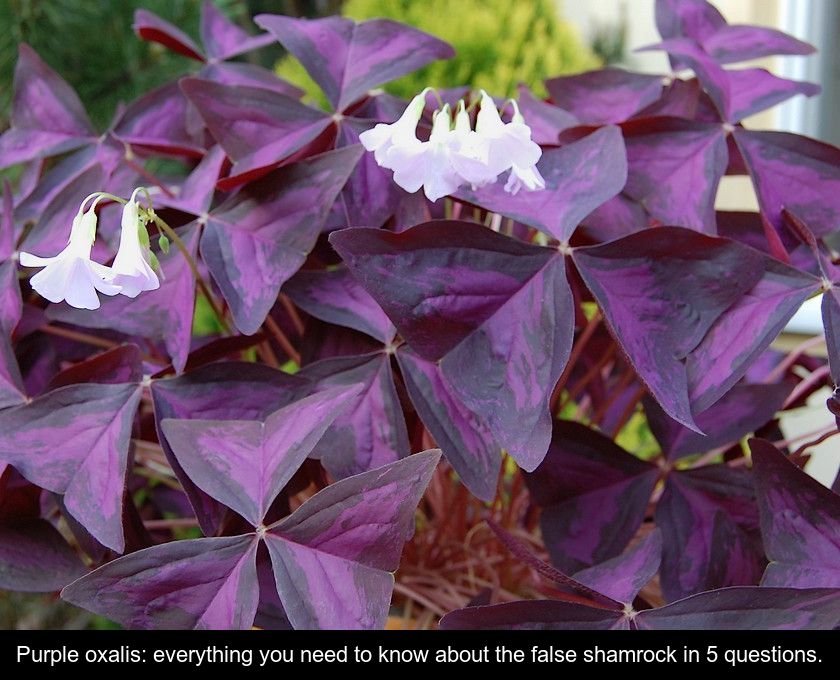Purple Oxalis: Everything You Need To Know About The False Shamrock In 5 Questions.
Purple oxalis, also known as Oxalis triangularis or false shamrock, is a plant highly appreciated for its colorful foliage. This plant, perfect for hanging culture, is unmatched in bringing a touch of color to your interior. Here's everything you need to know about the cultivation and maintenance of this plant in 5 questions.
"Why and how to choose a purple oxalis?"
Buying a purple oxalis is often motivated by the desire to add a touch of color to the midst of green plants. The main asset of the oxalis triangularis is indeed to have a magnificent violet foliage!
This plant from the Oxalidaceae family is native to South America. Highly appreciated for its foliage, it also produces small mauve flowers from May to July when provided with sufficient brightness.
Attention: this plant is toxic to animals! If you have a cat or other pet, make sure to install it out of reach, for example in a suspension that will highlight its beautiful foliage.
At the time of purchase, to choose your oxalis well, check the number of starts at the substrate level and choose a specimen with a maximum of stems. Also make sure that the stems are not etiolated. You will thus have a well-stocked plant.
Note: if you have a green thumb and want to save money, you can also buy oxalis bulbs in garden centers or online and plant them yourself.
2- Where to plant a purple oxalis?
The purple oxalis, which is well adapted for indoor cultivation, appreciates a temperature of around 18°C. Therefore, you can install it in your bedroom, provided that you provide it with a bright exposure.
The false shamrock needs to receive light to flourish. The brighter the room's exposure, the faster its growth and abundant flowering.
However, be sure not to place it behind a window! Install the plant under indirect light, behind a light curtain, for example, especially if your window faces south.
3- How to care for a purple oxalis?
Purple oxalis is a plant that is rather easy to maintain. In the summer, it needs to be watered sufficiently so that the soil remains always moist. But be careful not to let stagnant water at the bottom of the pot or in the saucer!
In winter, you can space out the watering and let the soil dry on the surface before watering again. In any case, the foliage should not be wet. That's why some people prefer to water the pot by avoiding putting the leaves in contact with water.
Note that to promote flowering from May onwards, you can put the plant in hibernation in winter. To do this, stop watering in early December and let the soil dry completely. Once the soil is dry, cut all the stems and place the pot away from light sources and heat. At the beginning of March, you can put the pot back in a bright room and resume watering.
Taking care of the false shamrock also involves:
• regularly cleaning the leaves
• rotating the plant a quarter turn every month to maintain a harmonious shape
• cutting off withered stems in early spring
• providing fertilizer once a month from March to September to stimulate the production of new leaves.
4- When should a purple oxalis be repotted?
Purple oxalis being a fast-growing plant, you will probably need to repot it every 2 years on average.
Repotting is best done at the beginning of March, before the start of vegetation.
This operation, which allows the plant to be given a richer soil, is also an opportunity to multiply it by dividing the bulbs. When you remove the root ball from its pot, gently collect the bulbs and divide them.
5- Why does my purple oxalis look sick?
Don't worry if you notice that the leaves of your purple oxalis are closing at the end of the day! The leaves simply react to the light intensity of the room and will reopen the next day at sunrise.
However, if the leaves close during the day, it is a sign that your plant is not receiving enough light and you should find a brighter location for it.
If powdery yellow-orange spots appear on the leaves, it is probably rust, a disease caused by a fungus. To treat the plant, trim the leaves affected by the disease and use a fungicide.
If all the stems have withered, you may think that your plant is dead and that you have to throw it away... But no! Don't throw it away because your oxalis is simply dormant! If you take care of it again, the bulbs will sprout and the plant will grow back.













